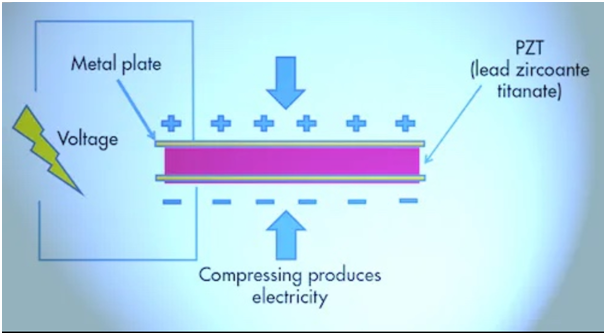Piezoelectric effect
Context: Recently scientists have reported evidence of the piezoelectric effect in liquids for the first time. The effect was found in 2 ionic liquids (liquids which are made of ions instead of molecules) at room temperature.
What is the piezoelectric effect?
- In the piezoelectric effect, a body develops an electric current when it is squeezed.
- Quartz is the most famous piezoelectric crystal; it is used in analog wristwatches and clocks.
- Such crystals are also used in other instruments where converting mechanical stress to a current is useful.
- Quartz is silicon dioxide (SiO2). The quartz crystal consists of silicon and oxygen atoms at the four vertices of a three-sided pyramid; each oxygen atom is shared by two pyramids.
- These pyramids repeat themselves to form the crystal. The effective charge of each pyramid is located slightly away from the centre. When a mechanical stress is applied, that is when the crystal is squeezed, the position of the charge is pushed further from the centre, giving rise to a small voltage. This is the source of the effect.
Why is the effect in liquids surprising?
- The reason the piezoelectric effect has only been expected in solids thus far is that the body being squeezed needs to have an organised structure, like the pyramids of quartz.
- Liquids don’t have such structure as they take the shape of the container.
- Physicists explain the effect using a combination of Hooke’s law — that the force required to squeeze an object is linearly (i.e. non-exponentially) proportional to the amount of squeezing — and the properties of dielectric materials.
- These are materials that don’t conduct electricity but whose electrons are still mildly affected by an electric field. Hooke’s law is not clear when the body isn’t very compressible.
- It will be early to claim this requires a complete rethink of the physics of piezoelectric but the observation of the effect in ionic liquids appears on its face to be inconsistent with the current model.
- An implication of findings is the existence of some manner of organisation in ionic liquids that is not seen in ‘normal’ liquids.
Possible Application
- The discovery opens the door to applications that have previously not been accessible with solid-state materials, and [room-temperature ionic liquids] are more readily recyclable and in many instances pose fewer environmental issues than many currently used piezoelectric materials.
- The liquids also displayed the inverse piezoelectric effect: they became distorted when an electric charge was applied.
- This fact could be used to control how the liquids bent light passing through them by passing different currents through them. That is, using this simple control mechanism, vials of these liquids could be lenses with dynamic focusing abilities.
| Practice Question
1. What is the Piezoelectric effect? What are the possible application of the effect after the new discovery?
|




